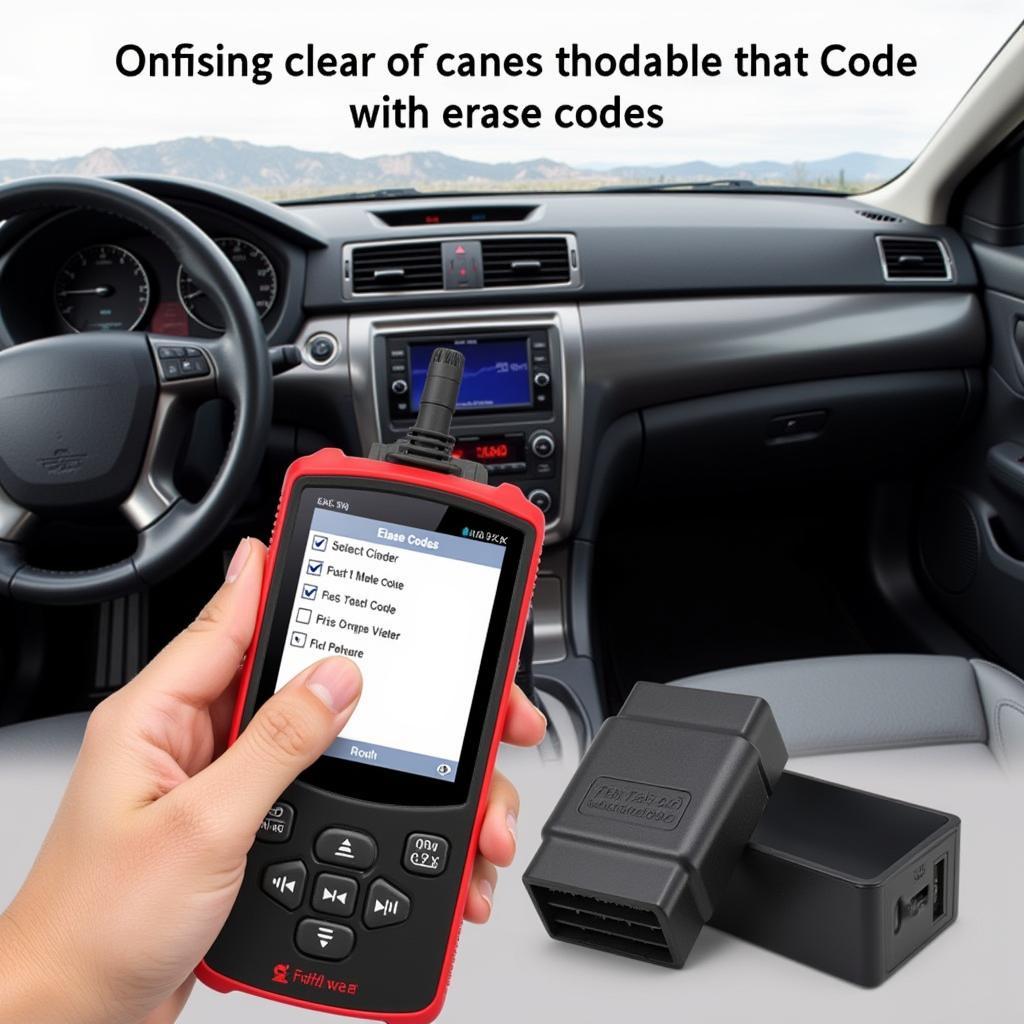Knowing how to erase a permanent OBD2 code is essential for any car owner. While the thought of a “permanent” code might sound daunting, understanding their nature and how to address them can save you unnecessary trips to the mechanic and potential expenses. This comprehensive guide will demystify permanent OBD2 codes, providing you with the knowledge and steps to potentially erase them yourself.
Understanding OBD2 Codes: Permanent vs. Temporary
Before we delve into the “how-to,” it’s crucial to differentiate between permanent and temporary OBD2 codes.
Temporary codes, as their name suggests, are fleeting. They indicate a temporary malfunction that the vehicle’s onboard computer, the Engine Control Unit (ECU), has detected. These codes often resolve themselves once the underlying issue is rectified or after a specific number of driving cycles.
Permanent codes, however, are a bit more persistent. They signal that the ECU has detected a recurring issue that hasn’t been resolved despite multiple driving cycles. These codes are stored in the ECU’s memory and often require a more in-depth diagnosis and repair.
Can You Erase a Permanent OBD2 Code?
The answer, like many things automotive, is: it depends.
While the term “permanent” might sound intimidating, it doesn’t always signify an irreversible issue. In some cases, a permanent OBD2 code can be cleared using an OBD2 scanner after successfully addressing the root cause of the problem.
However, it’s essential to understand that simply erasing the code does not fix the underlying mechanical or electrical issue. If the problem persists, the code will reappear, often after a specific number of driving cycles.
When Can You Erase a Permanent OBD2 Code?
Here are common scenarios where erasing a permanent OBD2 code might be possible:
- Successful Repair: Once you’ve diagnosed and fixed the underlying issue triggering the code, you can use an OBD2 scanner to clear it.
- Intermittent Issues: Sometimes, temporary glitches or sensor malfunctions can trigger permanent codes. If the issue resolves itself and doesn’t reoccur after a reasonable period, you can attempt to clear the code.
How to Erase a Permanent OBD2 Code: A Step-by-Step Guide
Before proceeding, it’s crucial to reiterate that erasing a code without addressing the root cause is like silencing a fire alarm without putting out the fire. It’s a temporary solution that masks a potentially bigger problem.
If you’re confident that the underlying issue has been resolved, here’s a general guide on how to erase a permanent OBD2 code using a standard OBD2 scanner:
- Locate Your OBD2 Port: Typically found under the driver’s side dashboard.
- Connect the OBD2 Scanner: Plug the scanner into the port.
- Turn the Ignition ON: Turn the key to the “on” position without starting the engine.
- Establish Connection: Allow the scanner to establish communication with your vehicle’s ECU.
- Read Codes: Navigate to the “Read Codes” function on your scanner. This will display all stored codes.
- Select “Erase Codes”: Once you’ve identified the permanent code you want to clear, navigate to the “Erase Codes” or “Clear Codes” function.
- Confirm Erasure: The scanner might ask for confirmation. Proceed to erase the code.
- Verify Erasure: After the erasure process, re-read the codes to ensure the permanent code is gone.
 Erasing a Permanent OBD2 Code
Erasing a Permanent OBD2 Code
Important Note: The specific steps and terminology might vary slightly depending on your OBD2 scanner model. Always refer to your scanner’s user manual for precise instructions.
OBD2 Scanners for Erasing Permanent Codes
Choosing the right OBD2 scanner can simplify the process of erasing permanent codes and diagnosing car problems. Here are two popular options to consider:
- OBD2 Bluetooth Advance Auto Parts: These scanners connect to your smartphone via Bluetooth, offering a user-friendly interface and convenient access to advanced diagnostic features. obd2 bluetooth advance auto parts will give you more information.
- FIXD Bluetooth OBD2: Another excellent option for smartphone connectivity, FIXD scanners provide real-time data, code definitions, and potential repair cost estimates, making it easier to manage car maintenance. You can find more details about FIXD Bluetooth OBD2.
When Erasing a Code Doesn’t Work
If a permanent code persists even after addressing the potential cause and following the erasure procedure, it’s crucial to consider these factors:
- Complex Issue: The underlying problem might be more complex than initially diagnosed, requiring specialized tools or professional expertise.
- Faulty Components: A malfunctioning sensor, wiring issue, or other faulty components could be the culprit.
- ECU Problems: In rare cases, a faulty ECU might be causing the code to reappear.
Seeking Professional Help
While DIY approaches can be helpful for simple issues, there are situations where seeking professional help is recommended:
- Recurring Codes: If a code persists or reappears despite multiple attempts to diagnose and repair the issue.
- Complex Systems: When dealing with complex vehicle systems, such as transmission, airbags, or ABS, professional expertise is advised.
- Lack of Expertise: If you’re uncomfortable or unfamiliar with car diagnostics and repairs, it’s always best to consult a professional.
Conclusion
Understanding how to erase a permanent OBD2 code empowers car owners to address minor issues and manage their vehicle’s health effectively. While the process itself can be straightforward, it’s vital to remember that erasing a code is not a substitute for proper diagnosis and repair. By combining knowledge, the right tools, and professional guidance when needed, you can keep your car running smoothly and address those pesky permanent codes.


